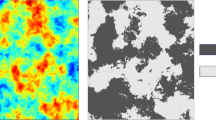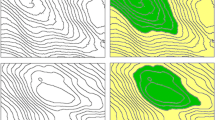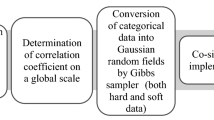Abstract
Simulating a depositional (or stratigraphic) sequence conditionally on borehole data is a long-standing problem in hydrogeology and in petroleum geostatistics. This paper presents a new rule-based approach for simulating depositional sequences of surfaces conditionally on lithofacies thickness data. The thickness of each layer is modeled by a transformed latent Gaussian random field allowing for null thickness thanks to a truncation process. Layers are sequentially stacked above each other following the regional stratigraphic sequence. By choosing adequately the variograms of these random fields, the simulated surfaces separating two layers can be continuous and smooth. Borehole information is often incomplete in the sense that it does not provide direct information about the exact layer that some observed thickness belongs to. The latent Gaussian model proposed in this paper offers a natural solution to this problem by means of a Bayesian setting with a Markov chain Monte Carlo (MCMC) algorithm that can explore all possible configurations that are compatible with the data. The model and the associated MCMC algorithm are validated on synthetic data and then applied to a subsoil in the Venetian Plain with a moderately dense network of cored boreholes.















Similar content being viewed by others
References
Allard D, Froidevaux R, Biver P (2006) Conditional simulation of multi-type non stationary Markov object models respecting specified proportions. Math Geol 38(8):959–986
Allard D, D’Or D, Froidevaux R (2011) An efficient maximum entropy approach for categorical variable prediction. Eur J Soil Sci 62(3):381–393
Allcroft DJ, Glasbey CA (2003) A latent Gaussian Markov random-field model for spatiotemporal rainfall disaggregation. J R Stat Soc Ser C Appl Stat 52(4):487–498
Armstrong M, Galli A, Beucher H, Loc’h G, Renard D, Doligez B, Eschard R, Geffroy F (2011) Plurigaussian simulations in geosciences. Springer, Berlin
Baxevani A, Lennartsson J (2015) A spatiotemporal precipitation generator based on a censored latent Gaussian field. Water Resour Res 51(6):4338–4358
Benoit L, Allard D, Mariethoz G (2018a) Stochastic rainfall modeling at sub-kilometer scale. Water Resour Res 54(6):4108–4130
Benoit N, Marcotte D, Boucher A, D’Or D, Bajc A, Rezaee H (2018b) Directional hydrostratigraphic units simulation using MCP algorithm. Stoch Environ Res Risk Assess 32(5):1435–1455
Bertoncello A, Sun T, Li H, Mariethoz G, Caers J (2013) Conditioning surface-based geological models to well and thickness data. Math Geosci 45(7):873–893
Beucher H, Galli A, Le Loc’h G, Ravenne C, Group H et al (1993) Including a regional trend in reservoir modelling using the truncated Gaussian method. In: Soares (ed) Geostat Tróia’92. Kluwer, pp 555–566
Carle SF, Fogg GE (1996) Transition probability-based indicator geostatistics. Math Geol 28(4):453–476
Chilès J-P, Delfiner P (2012) Geostatistics: modeling spatial uncertainty, 2nd edn. Wiley, New York
Comunian A, Renard P, Straubhaar J (2012) 3D multiple-point statistics simulation using 2D training images. Comput Geosci 40:49–65
Comunian A, Jha SK, Giambastiani BM, Mariethoz G, Kelly BF (2014) Training images from process-imitating methods. Math Geosci 46(2):241–260
Cressie N (1993). Statistics for spatial data, revised edition. Wiley, New York
Fabbri P, Piccinini L, Marcolongo E, Pola M, Conchetto E, Zangheri P (2016) Does a change of irrigation technique impact on groundwater resources? A case study in Northeastern Italy. Environ Sci Policy 63:63–75
Fuglstad G-A, Simpson D, Lindgren F, Rue H (2019) Constructing priors that penalize the complexity of Gaussian random fields. J Am Stat Assoc 114(525):445–452
Galli A, Beucher H, Le Loc’h G, Doligez B, Group H (1994) The pros and cons of the truncated Gaussian method. Geostatistical simulations. Springer, Berlin, pp 217–233
Gelfand AE (2000) Gibbs sampling. J Am Stat Assoc 95(452):1300–1304
Genz A, Bretz F (2009) Computation of multivariate normal and t probabilities. Lecture notes in statistics, Springer, Heidelberg
Genz A, Bretz F, Miwa T, Mi X, Leisch F, Scheipl F, Hothorn T (2019) mvtnorm: multivariate normal and t distributions. R package version 1.0-11
Le Blévec T, Dubrule O, John CM, Hampson GJ (2017) Modelling asymmetrical facies successions using pluri-Gaussian simulations. Geostatistics Valencia 2016. Springer, Berlin, pp 59–75
Le Blévec T, Dubrule O, John CM, Hampson GJ (2018) Geostatistical modelling of cyclic and rhythmic facies architectures. Math Geosci 50(6):609–637
Liu L, Shih Y-CT, Strawderman RL, Zhang D, Johnson BA, Chai H et al (2019) Statistical analysis of zero-inflated nonnegative continuous data: a review. Stat Sci 34(2):253–279
Marcotte D, Allard D (2018) Gibbs sampling on large lattice with GMRF. Comput Geosci 111:190–199
Mariethoz G, Caers J (2014) Multiple-point geostatistics: stochastic modeling with training images. Wiley, New York
Martinetti D, Geniaux G (2017) Approximate likelihood estimation of spatial probit models. Region Sci Urban Econ 64:30–45
Matheron G, Beucher H, De Fouquet C, Galli A, Guerillot D, Ravenne C et al (1987) Conditional simulation of the geometry of fluvio-deltaic reservoirs. In: SPE annual technical conference and exhibition. Society of Petroleum Engineers
Pyrcz MJ, Sech RP, Covault JA, Willis BJ, Sylvester Z, Sun T, Garner D (2015) Stratigraphic rule-based reservoir modeling. Bull Can Pet Geol 63(4):287–303
Sartore L, Fabbri P, Gaetan C (2016) spMC: an R-package for 3D lithological reconstructions based on spatial Markov chains. Comput Geosci 94:40–47
Simpson D, Rue H, Riebler A, Martins TG, Sørbye SH et al (2017) Penalising model component complexity: a principled, practical approach to constructing priors. Stat Sci 32(1):1–28
Strebelle S (2002) Conditional simulation of complex geological structures using multiple-point statistics. Math Geol 34(1):1–21
Syversveen AR, Omre H (1997) Conditioning of marked point processes within a Bayesian framework. Scand J Stat 24(3):341–352
Tanner MA (1996) Tools for statistical inference: methods for the exploration of posterior distributions and likelihood functions. Springer, Berlin
Zhang H (2004) Inconsistent estimation and asymptotically equal interpolations in model-based geostatistics. J Am Stat Assoc 99(465):250–261
Acknowledgements
This work was initiated during a visit of the first author to Ca’ Foscari University of Venice. He acknowledges the support of that institution. We wish to thank two anonymous reviewers for their in-depth and detailed reading of the first version of the manuscript. Their many valuable comments helped us to improve the manuscript.
Author information
Authors and Affiliations
Corresponding author
Appendix A: A Longer Example of Incomplete Sequence
Appendix A: A Longer Example of Incomplete Sequence
See Table 5.
Rights and permissions
About this article
Cite this article
Allard, D., Fabbri, P. & Gaetan, C. Modeling and Simulating Depositional Sequences Using Latent Gaussian Random Fields. Math Geosci 53, 469–497 (2021). https://doi.org/10.1007/s11004-020-09875-0
Received:
Accepted:
Published:
Issue Date:
DOI: https://doi.org/10.1007/s11004-020-09875-0




